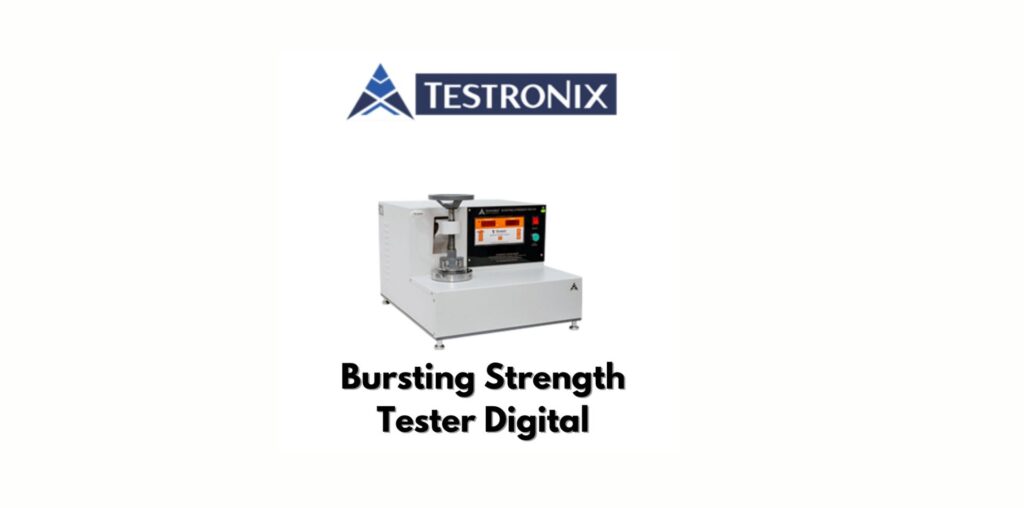In the textile industry, strength and durability are two vital parameters that define fabric quality. A commonly used method to determine these characteristics is the bursting strength test, which measures the force required to rupture the fabric. With advancements in technology, the digital bursting strength tester has emerged as a reliable and accurate solution for textile testing.
This article explores how digital equipment enhances accuracy and outlines the standard bursting strength tester procedure for quality assessment.
What Is a Digital Bursting Strength Tester?
With the demand for fast and precise textile testing growing, many labs have moved to digital instruments for better efficiency. A digital bursting strength tester is a microprocessor-based device that applies hydraulic pressure through a rubber diaphragm until the fabric bursts.
It displays real-time values and automates several steps of the test, offering higher precision than traditional models. These testers also support features like data storage, digital calibration, and connectivity for easy report generation.
Importance of Bursting Strength Testing in Textiles
Fabric performance depends on how well it can resist pressure from different directions, making bursting strength a crucial factor. This type of testing is commonly used across industries like sportswear, healthcare textiles, upholstery, and packaging.
It ensures that the material can endure usage stress, environmental factors, and mechanical pressure. Poor bursting strength can result in product failures, quality issues, and even safety hazards, especially in high-performance applications.
Bursting Strength Tester Procedure: Step-by-Step Guide
Following a consistent procedure is essential for obtaining accurate and repeatable results in textile testing:
1. Sample Preparation
Cut circular test samples using a standardized cutter. Make sure the specimens are free from wrinkles, tears, or folds to avoid skewed results.
2. Clamping the Specimen
Place the fabric on the diaphragm and secure it using the clamping mechanism. Proper alignment and tension are critical at this stage to prevent slippage.
3. Setting the Test Parameters
Use the digital interface to select pressure units, test speed, and other relevant configurations. These settings can vary depending on the fabric type.
4. Running the Test
Activate the machine to gradually apply hydraulic pressure. The pressure increases until the fabric bursts, and the tester automatically records the peak value.
5. Recording the Results
The peak pressure at burst is displayed and stored digitally. Some machines also allow exporting data or printing results instantly.
6. Post-Test Analysis
Compare the values against quality benchmarks or industry standards to determine whether the fabric batch passes the test.
This bursting strength tester procedure ensures systematic testing with minimal human interference and maximum consistency.
How Digital Testers Improve Accuracy in Textile Testing
- Consistency in Test Application: Manual testers often vary based on the operator’s handling, clamping pressure, and diaphragm inflation speed. Digital models use preset automated cycles, eliminating these inconsistencies.
- Enhanced Data Logging: Modern digital testers come with built-in memory and report generation capabilities. This allows textile manufacturers to maintain detailed test records and compare batch performance over time.
- Faster Turnaround Time: With intuitive touch panels and automated calibration, digital testers significantly reduce setup time and allow high-volume testing with minimal supervision.
- Integration with Lab Management Systems: Many advanced digital testers offer USB or Wi-Fi connectivity, enabling integration with LIMS (Laboratory Information Management Systems) for seamless data transfer and compliance.
- User-Friendly Interface: The digital display provides real-time feedback, allowing operators to make quick decisions or run repeated tests effortlessly, increasing both efficiency and confidence in the results.
Applications of Digital Bursting Strength Testers in the Textile Industry
Digital bursting strength testers have become essential tools across various segments of the textile industry, from research labs to mass production units.
In quality control departments, they help ensure that every fabric batch meets strength standards before reaching the market. R&D teams use these machines to test the performance of new textile blends or treatments, helping innovate stronger, more durable materials. These testers also play a critical role in compliance testing, where fabric strength must meet national or international standards like ASTM or ISO certifications.
Whether it’s apparel manufacturing, home furnishings, industrial textiles, or medical fabrics, digital bursting strength testers provide reliable data to assess performance and durability. Their accuracy and ease of use make them ideal for both routine testing and advanced product development.
Conclusion
Digital technology has elevated textile testing by making it faster, smarter, and more accurate. A digital bursting strength tester not only simplifies the testing process but also brings consistency to critical quality checks. Following the right bursting strength tester procedure ensures dependable results and better decision-making for manufacturers.
For textile businesses aiming to deliver superior quality, switching to digital testing tools is a step toward reliability, efficiency, and excellence.




